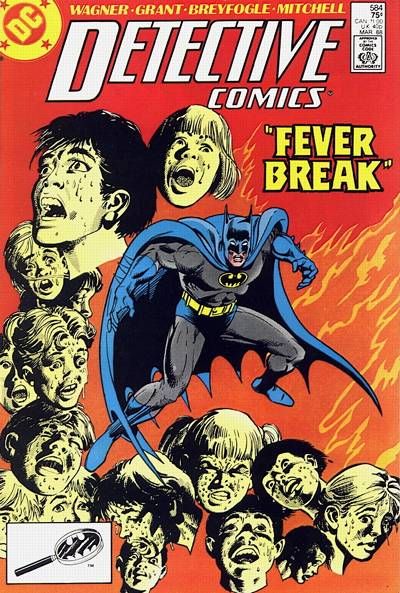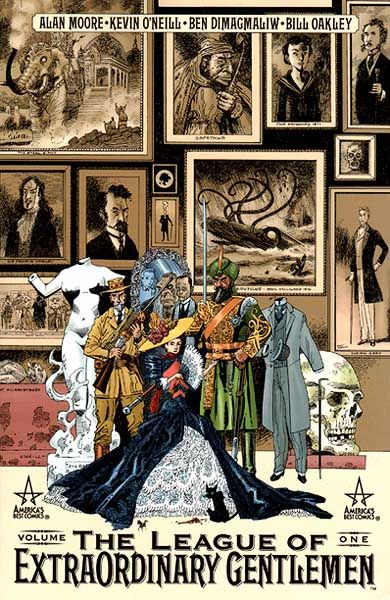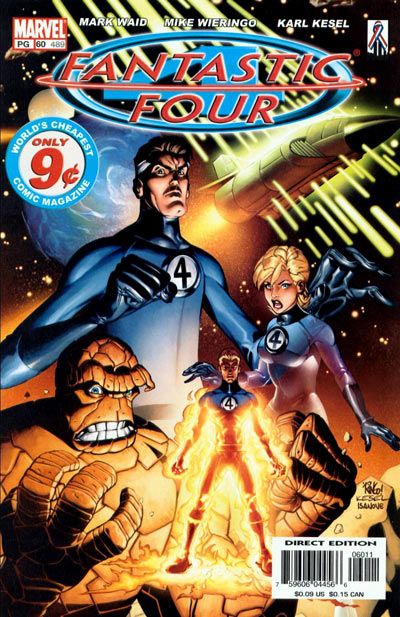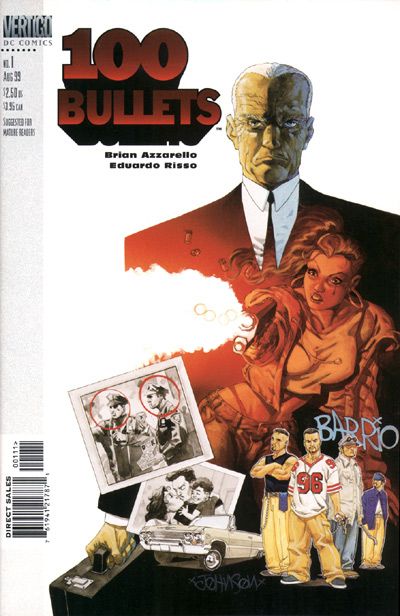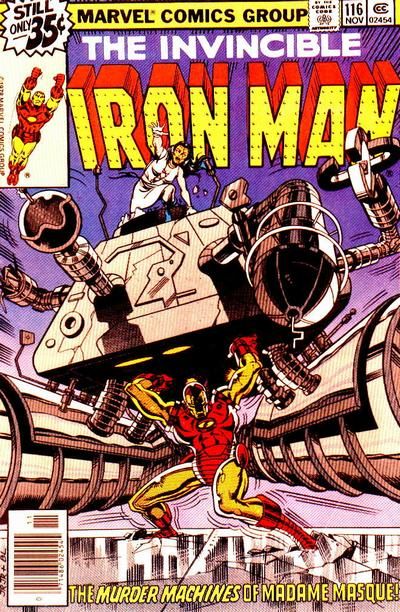Here are the next five runs in the countdown of the top 100 favorite runs, based on the votes of about 700 readers of Comics Should Be Good, who chose their favorite runs, voted for them, I tabulated the results, and now we're counting them down.
Enjoy!
65. Alan Grant and Norm Breyfogle's Batman - 146 points (2 first place votes)
Detective Comics #583-594, 601-621, 627, Batman #455-466, 470-476, Shadow of the Bat #1-5
As I related in an installment of Urban Legends Revealed, when Alan Grant began his run on Detective Comics with co-writer, John Wagner, the two were not even making royalties on the comic, that's how low Detective Comics was selling. Then the Batman movie hit, and suddenly, the books were goldmines again.
So to a whole generation of new Batman readers, the creative team of Alan Grant (Wagner left right before the movie kicked in) and artist Norm Breyfogle were their introduction to the world of Batman, and what an introduction it was!
Grant's specialty during his run on Detective Comics was to introduce new Batman characters, including the memorable Ventriloquist and Scarface, Cornelius Stirk, Anarky and more.
Breyfogle's stylized Batman soon became the Batman for the aforementioned new generation of Batman fans, and Breyfogle's professionalism did him proud, as well, as he did an extraordinary amount of issues in a day and age when six monthly issues in a row is an achievement.
DC moved the pair from Detective to their flagship book, Batman, in 1990, where they introduced the new costume for Robin (designed by Neal Adams, but first drawn by Breyfogle).
In 1992, DC launched a brand new Batman book, The Shadow of the Bat, which was, in a way, a bit of a make-up for taking the pair off of Detective Comics right before #600 (imagine the royalties on that baby! The 600th issue of Batman right after the movie came out? Yowsa!), as a new Batman comic on the eve of the Batman film sequel was a good combination.
In this arc, their last sustained effort on Batman together, they introduced their last memorable new villain, the sadistic Mr. Zsasz.
64. Alan Moore and Kevin O'Neill's League of Extraordinary Gentlemen - 148 points (2 first place votes)
The League of Extraordinary Gentlemen #1-6, The League of Extraordinary Gentlemen, Vol. 2 #1-6, The League of Extraordinary Gentlemen: The Black Dossier Original Graphic Novel
The League of Extraordinary Gentlemen is the ultimate Wold Newton experience, as writer Alan Moore and artist Kevin O'Neill have put together a team of heroes consisting of characters from notable works of fiction, all from the same time period.
In the initial team, there was Mina Murray (from Dracula), Mr. Hyde (duh), The Invisible Man (again, duh), Captain Nemo (still duh) and Allan Quatermain (perhaps not duh).
What was notable about the book was the attention to detail. O'Neill made sure to draw the book as though it was set during the late 1890s, and Moore made sure to fit all of the stories so that they would flow fairly seamlessly with the actual stories, based on when they were published (Moore would later do much of the same with his Lost Girls series).
In addition, the story was filled to the brim with little references to other stories, be it Poe or Pollyanna.
If this were not enough, the stories were just plain interesting in and of themselves! They were awfully fun adventure stories, particularly in the second volume, where Moore integrates all the various depictions of Mars into one cohesive idea of the planet and its inhabitants, just in time for Mars to invade Earth.
Moore has announced plans to continue the League throughout time, keeping Quatermain and Murray as his constants (having given both of them a measure of immortality).
The book was originally published by DC, but now Top Shelf will make new installments.
There was a forgettable movie version made awhile back.
62. Mark Waid and Mike Wieringo's Fantastic Four - 150 points (1 first place votes)
Fantastic Four Vol. 3 #60-70, Fantastic Four #500-524 (Wieringo as artist of 27 of the 36 issues)
The Fantastic Four was Mark Waid's triumphant return to Marvel, after some time at DC and Crossgen.
His run, along with the late, great Mike Wieringo, tried to inject new life and verve into the world of the Fantastic Four, through way-out stories and superheroics that were truly fantastic.
After introducing some new characters in his first few issues, Waid probably made his most notable addition to the Fantastic Four mythos when he revamped Doctor Doom, having the power-mad villain kill his childhood love to gain mystical powers, including a new suit of armor made out of her flesh (gruesome, eh?).
At the end of the battle, Doom was left in hell, so Waid had a story where the Fantastic Four essentially take over Doom's country of Latveria to dispose of Doom's weapon stock - this does not go over well with the governments of the world. Meanwhile, Doom also returns as a ghost of sorts, and after a kerfluffle, the Fantastic Four are forced to travel to heaven itself to win back the soul of a deceased member of the team.
This trip to heaven includes a nod to Jack Kirby (having him be God).
Later stories included a Galactus story, where Galactus becomes human for a time.
Waid and Wieringo were then to launch a Spider-Man title together, but that fell through for whatever reason.
62. Brian Azzarello and Eduardo Risso's 100 Bullets - 150 points (3 first place votes)
100 Bullets #1-current (#89)
At first glance, 100 Bullets was a simple concept. A guy named Agent Graves would come up to people with an attache case containing a gun with 100 bullets, plus a photograph of a target, including proof that the target was responsible for whatever woes existed in the person's life. The offer? Use the gun to get revenge, and if you use the bullets given, you will never be arrested for the crime.
This was the simple concept at first, as Graves went to random people making the offer, and each person would have different reactions to the offer.
However, over time, readers learn that there is a method to the seemingly random offers, and it all ties to a msysterious group called the Minutemen who are tied to an equally mysterious Trust.
Writer Brian Azzarello has created a sprawling and engaging mystery comic that will truly take the full 100 issues alloted to him to tell the whole story, which is an impressively ambitious feat on his part.
Azzarello's partner in crime is artist Eduardo Risso, who is a master of noir art, so he fits in perfectly on this style of comic. When I say partner, I mean partner, as the two have worked together on every single issue of 100 Bullets, which is an impressive level of commitment by DC to the creative team, as they are on a schedule of "when you get the issues done, you get them done."
In fact, the book even went on hiatus for a time when the entire creative team (colorist, letterer, editor, all of them) took over Batman for six months when DC hired Azzarello and Risso to do an arc of Batman.
This is a book made by a creative team that cares about each other.
The story of the comic is filled with characters that readers grow to care about, even if they are enigmatic and hard to understand.
I must not forget to mention cover artist, Dave Johnson, who is as much a part of the book's success as anyone else, with his absolutely stunning cover work.
When this comic ends within the next year or so at #100, we will be losing one of the best crime comics out there. I hope Azzarello and Risso have something worked up for a follow-up.
61. Bob Layton and David Michelinie's 1st Run on Iron Man - 152 points (2 first place votes)
Iron Man #114-157
When David Michelinie and Bob Layton took over the writing chores on Iron Man, it was in the middle of a storyline - so they were not even in control of the plot they were writing. By the time they left the book, however, they had more than made their stamp on the title.
Easily the most memorable aspect of their run was their storyline where they had Tony Stark develop a problem with alcoholism. The "Demon in a Bottle" storyline was one of the most notable stories of the 1980s, resulting in one of the very first trade paperback collections (along with Dark Phoenix Saga) of a modern comic book story.
If all they did was the "Demon in a Bottle" story, Layton and David Michelinie' would be notable, but their run had plenty of other notable stories, highlighted throughout by strong artwork, first by John Romita Jr., and eventually by Bob Layton himself.
Even before he began penciling the book, Layton's strong inks gave the book a consistent feel, no matter who was drawing the book.
Their run had a great deal of memorable action stories, as the pair attempted to develop Tony Stark more, and in doing so, developed a new creation of theirs, Stark pilot and friend, James Rhodes. Rhodey would become important during their run, and would become even MORE important after they left, as he would fill in for Tony as Iron Man for awhile. Besides Rhodey, the writing pair stressed Tony's ass-kicking girlfriend, Bethany Cabe.
During the run, Michelinie and Layton also introduced Justin Hammer, the rich industrialist who was secretly funding all the low-level supervillains who used technology for their powers.
Towards the end of their first run (they would return four or so years after they left for an extended second run, during which they would have the noted Armor Wars storyline, and debuted a new Iron Man armor), Layton and Michelinie had one of their most notable stories, which was just reprinted this past week (and a sequel to the story is due out next week), where Iron Man and Doctor Doom were trapped in the time of King Arthur. It was a total classic.
Just like their run.


